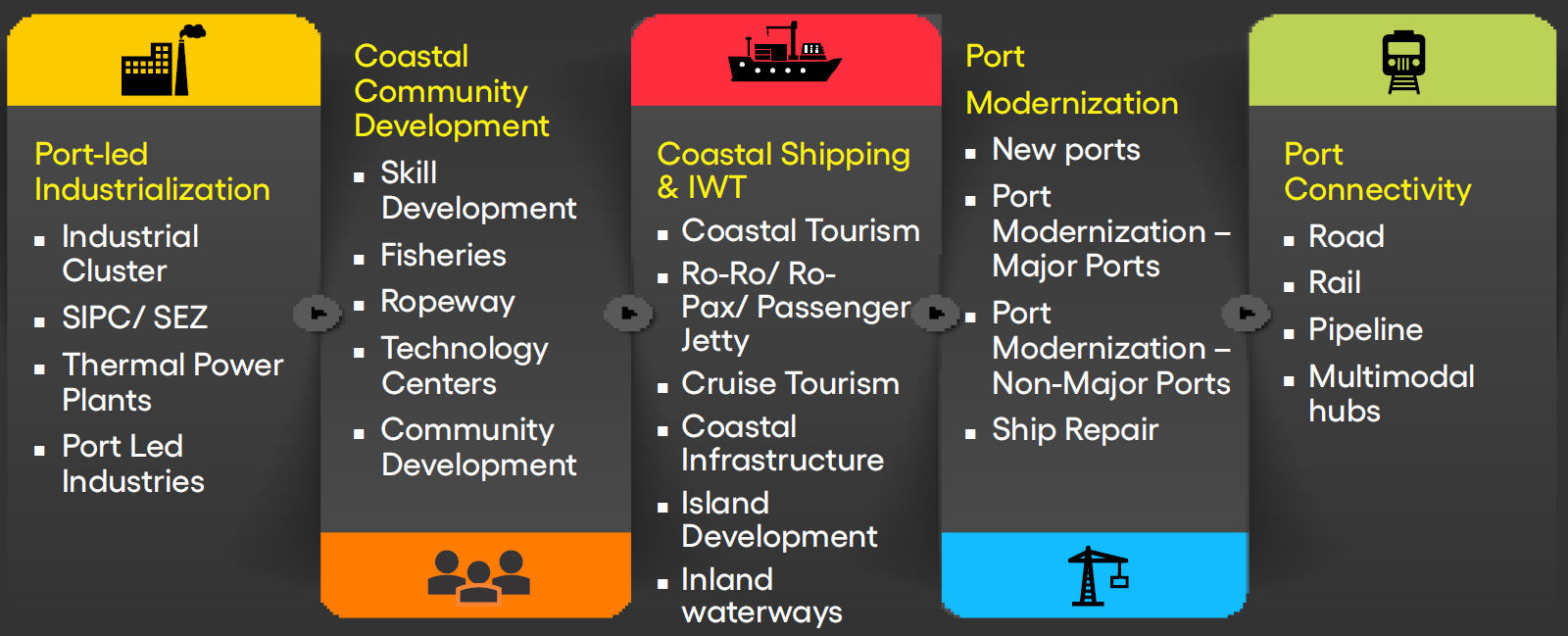Overview of Sagarmala Programme
The Sagarmala Programme, launched in March 2015, is the flagship initiative of the Ministry of Ports, Shipping, and Waterways, aimed at revolutionizing India’s maritime sector. With a 7,500 km coastline, 14,500 km of potentially navigable waterways, and a strategic position on key global trade routes, India holds immense potential for port-led economic growth. Sagarmala aims to streamline logistics, reduce costs, and enhance international trade competitiveness by shifting from traditional, infrastructure-heavy transport to efficient coastal and waterway networks. The program focuses on port modernization, industrial growth, job creation, and sustainable coastal development, ensuring minimal infrastructure investment while maximizing economic impact.
The Sagarmala Programme is a key pillar of the Maritime Amrit Kaal Vision 2047 (MAKV), driving India's ambition to become a global leader in maritime affairs. Building on Maritime India Vision 2030, MAKV sets ambitious targets, including 4 million GRT of shipbuilding capacity and 10 billion metric tons of port handling annually, aiming to position India among the top five shipbuilding nations by 2047.
Formulated through 150+ stakeholder consultations and an analysis of 50 global benchmarks, MAKV outlines over 300 strategic initiatives to develop world-class ports, expand coastal and inland waterways, and promote a sustainable Blue Economy. As a core enabler, Sagarmala plays a transformative role in enhancing logistics, infrastructure, and shipping, accelerating India's maritime growth by 2047.
Current Status of the Sagarmala Programme
As part of the Sagarmala Programme, around 839 projects, estimated to cost around 5.79 lakh crores, have been identified for implementation. Central ministries, IWAI, Indian Railways, NHAI, State Governments, Major Ports, and other relevant organizations implement these projects. 277 projects have been completed, which account for an investment of approximately 1.41 lakh crores.
Achievements of the Sagarmala Programme
Sagarmala has made India’s ports faster, boosted the coastal economy, revived inland waterways, and improved global logistics rankings. Coastal shipping grew 118% in a decade, Ro-Pax ferries moved over 40 lakh passengers, and inland waterway cargo rose 700%. Nine Indian ports rank in the world’s top 100, with Vizag in the top 20 container ports. Indian ports now outperform many advanced maritime nations on key metrics.
New additions to the Sagarmala Programme
Sagarmala 2.0
The Sagarmala 2.0 program aims to build on the successes of its first phase by addressing new challenges and seizing opportunities in the maritime sector. Under the “Viksit Bharat Mission,” India has set ambitious goals to enhance its maritime capabilities. One of the key objectives is to expand port capacity from the current ~2,700 million tonnes per annum (MTPA) to over 10,000 MTPA. This expansion aims to accommodate higher trade volumes and reduce logistics costs, thereby fuelling broader economic growth. The initiative seeks to create a more holistic and robust maritime ecosystem through enhanced Gross Budgetary Support (GBS) under the Sagarmala 2.0 Scheme, supporting economic growth while fostering environmental sustainability and social well-being.
Objectives of the Sagarmala Programme
With a strategic focus on port modernization, connectivity, industrialization, and skill development, the Sagarmala Programme is also unlocking new avenues for economic expansion, positioning India as a global maritime powerhouse. Sagarmala's vision can have a potentially transformative impact on India’s logistics competitiveness and the wider economy.
Overall set of projects are divided into 5 pillars and 24 categories











